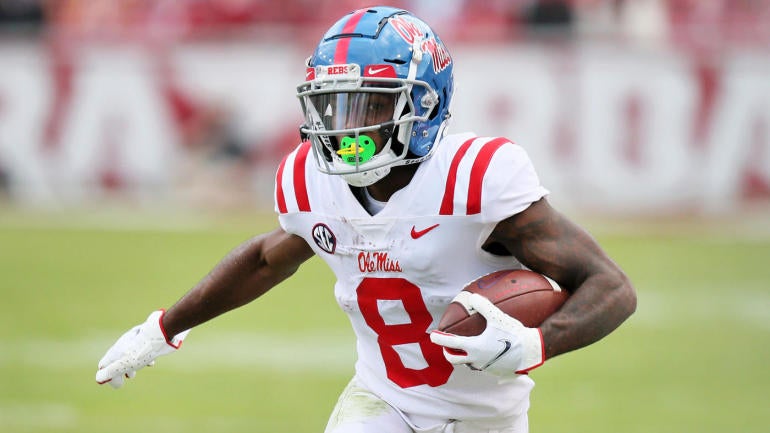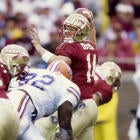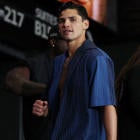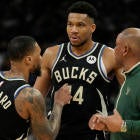
Which position group is the best in this draft class? That's a question NFL Draft analysts are asked every year, and every year it's important to take a step back and examine the class as a whole to identify when teams should prioritize certain positions.
Below, you'll see the number of first-round grades and top 100 grades I have at each position in the 2021 class. Those numbers are to simply provide a quantitative glimpse into my big board. For these rankings, there's no special formula based on those grades because positional value and positional scarcity need to be considered. The rankings are based on feel after comprehensively evaluating the 2021 NFL Draft class.
Wide receiver
First-round grades: 7 (Jaylen Waddle, Ja'Marr Chase, Devonta Smith, Rashod Bateman, Rondale Moore, Elijah Moore, Terrace Marshall)
Top 100 grades: 17
I have a hunch wide receiver will be a staple at or near the top of these rankings every year because of the way college football utilizes and highlights the position.
Waddle, Chase, and Smith represent my No. 4, No. 5, and No. 6 overall prospects in this class. They're special, all in their own ways. Bateman is vastly underrated. He brings a well-rounded game to the field every contest. Rondale Moore is a top 20 talent when healthy, and Elijah Moore is part super-twitchy possession slot, part big-play creator. Marshall is a large, downfield specialist who's a locomotive with the ball in his hands.
There'll be plenty of quality wideouts picked on Day Two and into the fourth round in this class too. Some names I really like in that range -- Florida's Kadarius Toney, Tennessee's Josh Palmer, Western Michigan's D'Wayne Eskridge, Clemson's Amari Rodgers, and North Carolina's Dyami Brown and Dazz Newsome (I like him more than most). Even the later rounds will produce gems like Houston's Marquez Stevenson, Iowa's Ihmir Smith-Marsette, UAB's Austin Watkins, Florida State's Tamorrion Terry, BYU's Dax Milne, and South Carolina's Shi Smith.
Pick two receivers in this class. Thank me later.
Quarterback
First-round grades: 4 (Trevor Lawrence, Zach Wilson, Justin Fields, Trey Lance)
Top 100 grades: 10
Mac Jones is graded early in the second round for me, so while I'm rooting for Ryan Wilson to be right on his Jones evaluation and mock draft slot at No. 3 overall, I just don't see "top-tier prospect" with Jones. Good quarterback in an amazingly quarterback-friendly system? Sure. Someone to elevate those around him? No.
My comparison for Lawrence is a more polished version of Justin Herbert. For Zach Wilson -- borrowing from NFL Media's Lance Zierlein -- a more athletic Jake Plummer. And Trey Lance? He's so similar to Josh Allen when he entered the league out of Wyoming.
After that, I really like the depth at the quarterback position, and it's headlined by two former top recruits. Stanford's Davis Mills -- the No. 1 pro-style quarterback in the 2017 class -- shows franchise quarterback flashes, his game is just rough around the edges. And I have to hand it to Feleipe Franks, the nation's No. 5 pro-style recruit in 2016 -- he rehabbed his career with an unexpectedly steady 2020 campaign at Arkansas. Both are big, athletic, cannon-armed quarterbacks unafraid of firing it through tiny passing lanes.
Then there's Kellen Mond, Jamie Newman, and Kyle Trask. Mond and Trask are more accomplished, game-managers (good connotation). Newman is the ultimate wild card because of flashes of athletic and arm talent brilliance we simply didn't get to see much of because of his limited starting experience at Wake Forest and a 2020 opt-out. I even like SMU's Shane Buechele, who transferred from Texas and plays with deceptive arm strength and outside-the-pocket ad-libbing talent. He's worth a late-round flier.
Craving even more NFL coverage focusing on previews, recaps, news and analysis? Listen below and follow the Pick Six podcast for a daily dose of everything you need to follow pro football.
Offensive tackle
First-round grades: 4 (Penei Sewell, Christian Darrisaw, Teven Jenkins, Rashawn Slater)
Top 100 grades: 14
Let's hear it for offensive tackle prospects. Second year in a row with a stellar class at that position after almost a decade of brutal, underwhelming groups, which at the time, seemed to mark the end of the idea that picking an offensive tackle was the "safest" route a team could take in Round 1.
Sewell is the Trevor Lawrence of offensive tackle prospects, a phenom who played remarkably while a teenager at a marquee program and enters the NFL with prodigious physical gifts from the gods. Darrisaw is flying under the radar, even though he's seemingly a first-round lock. Long, balanced, nasty -- he's a franchise tackle from the jump.
Glasses-wearing Jenkins looks like the nicest guy you'll ever meet -- on the field, he's a masher with effortless power, tremendous hand work, an unshakable equilibrium and deceptive athleticism. Then there's Slater -- whom the NFL is seemingly higher on than me -- a spectacular athletic specimen who plays with low-center-of-gravity pop and the agility needed to slide with advanced rushers.
But the hits keep coming after Round 1 -- and don't be surprised if Alabama's Alex Leatherwood hears his name called somewhere within the first 32 selections. His film is exceptionally boring to watch -- a good thing! -- and he tested like Trent Williams at Alabama's pro day. There's Lawrence's left tackle, Jackson Carman, who presumably slimmed down before his pro day to prepare himself for the speed in the NFL. He came out of the womb ready to negate edge rushers with steel beams for arms.
If we are to believe pro day figures, Texas' Samuel Cosmi had a legendary workout, and he showed improved anchoring strength in 2020. Nebraska's Brenden Jaimes started four years for the Huskers and pass protects like he's been in the NFL for five seasons. Quick with controlled strikes. Cincinnati's James Hudson plays more athletic than his workout, and has All-Pro upside if he's coached up on the fine details -- like patience -- needed to be a steady tackle. Long-time starters Liam Eichenberg of Notre Dame, and Brady Christensen of BYU can't be ignored either. They're both instant starters.
Even Texas A&M's Dan Moore and Carson Green have starting capabilities and they'll be available on Day Three. In a passing-obsessed NFL you need quality edge protectors, and this is the class to pick one -- if not two -- of them.
Cornerback
First-round grades: 4 (Caleb Farley, Asante Samuel, Greg Newsome, Patrick Surtain II)
Top 100 grades: 15
Because of the spread-out nature of offenses and the rules, it's not easy playing cornerback in today's NFL. That fact makes the position vital because the league is now predicated on passing efficiency and how well a defense stops the pass.
Similar to the receiver spot, college is pumping out NFL-ready cornerbacks every draft season, although last year's group failed to meet the hype, particularly the first rounders. Nonetheless, this year's class doesn't boast a marquee, Denzel Ward or Jalen Ramsey type bound to land inside the top five. The strength of this cornerback group resides within its top-end depth.
Farley is ready to contribute as a rookie -- if he's healthy. Samuel is the most underrated prospect of the top tier, simply because he's not particularly big, and he didn't have a phenomenal workout. He's sticky in coverage and genetics work in his favor when it comes to instinctively breaking on the football. Newsome is video-game twitchy, tenacious playing the ball in the air and has serious downfield speed. Scheme versatile.
Then there's Surtain, who's been soaking in press-man knowledge from his dad since he was in elementary school. That wealth of information and practice shows on the field, but even with serious NFL bloodlines, Surtain isn't as sudden or fast as other top corners in this class, and his ball awareness is surprisingly lacking. I'm not quite as high on Jaycee Horn due to his inconsistencies down the field in coverage, but he's as nasty and explosive at the line of scrimmage in an aggressive role as anyone in this class.
After that, there's a litany of second-round cornerbacks who'll be drafted at great value. Syacuse's Ifeatu Melifonwu, LSU's Kary Vincent Jr., UCF's Aaron Robinson, Kentucky's Kelvin Joseph, Georgia's duo of Eric Stokes and Tyson Campbell, Cal's Cam Bynum, and Washington's Elijah Molden.
Later on, there are long, athletic types who'll be available -- Minnesota's Benjamin St-Juste, Washington's Keith Taylor, UCF's Tay Gowan, and Stanford's Paulson Adebo -- along with feisty nickel types needed in every defense today -- Oklahoma's Tre Brown and Rodarius Williams, Georgia's DJ Daniel, App State's Shemar Jean-Charles, and Texas Tech's Zech McPhearson.
Edge rusher
First-round grades: 5 (Azeez Ojulari, Kwity Paye, Jaelan Phillips, Carlos Basham, Joseph Ossai)
Top 100 grades: 12
Edge rusher and cornerback are close in my estimation. Neither has a blue-chip prospect -- just many who are correctly valued between the middle of Round 1 and the the back portion of Round 3. Decent early starters with upside.
Ojulari stands out in a few ways from the rest of the top of the edge class -- he's smaller than his contemporaries but more explosive and bendier. There's stunning strength as a run defender too. Paye is a three-down linebacker now with an ascending skill set. Same goes for Ossai from Texas.
Phillips is about as well-rounded an edge prospect as you're going to see, and Basham has All-Pro flashes ... and midround flashes.
Penn State's Jayson Oweh is the darkhorse in the group. With him, you're betting on his sculpted frame and athletic gifts over his pass-rushing mastery right now. Pittsburgh's Rashad Weaver doesn't play to the impressiveness of his workout yet was ultra productive in college and uses his hands like a veteran. Houston's Payton Turner might be the most overlooked prospect at edge in the class. He has an NFL body with NFL strength right now, and he moves like he's much smaller. He can win with deadly pass-rushing moves too, and typically has a plan when attacking the corner. Oklahoma's Ronnie Perkins is your classic 3-4 outside linebacker with a springy, high-energy skill set, and Washington's Joe Tryon is a tall, thick linear rusher with an effective inside move.
After Round 3, you'll drift into unlikely-to-succeed territory at the edge spot in this class, but the first 100 picks or so are littered with quality prospects at that position.
Linebacker
First-round grades: 2 (Jeremiah Owusu-Koramoah, Micah Parsons)
Top 100 grades: 7
The more I watched the linebacker class, the more I liked. And what I mean by that is -- there are more "coverage-ready" linebackers in this class than I expected at the outset of evaluating this draft.
Owusu-Koramoah is my highest-graded defensive prospect. He's what people hoped Isaiah Simmons would be as a rookie. Parsons is more linebacker/edge rusher hybrid than someone who's going to have five interceptions and 10 pass breakups in a season, yet the blazing speed is there for him to eventually make a difference on pass plays in the NFL.
Then there's the oversized duo of Tulsa's Zaven Collins and Kentucky's Jamin Davis -- both likely first-round selections. I have them graded just outside Round 1 but absolutely see three-down ability with both of them, and they really bring it as blitzers. Collins can win around the edge too.
On Day Two, I love Ohio State's trio of Pete Werner, Justin Hilliard, and Baron Browning -- I have them graded in that order. Werner reminds of Fred Warner. Smooth City sinking in coverage then planting and driving on the football. Boston College's Isaiah McDuffie has elite short-area quickness and good range, Missouri's Nick Bolton can command a defense from the middle linebacker spot today, and LSU's Jabril Cox and North Carolina's Chazz Surratt are long, explosive coverage types. In a time when excelling at the linebacker spot has become exceedingly difficult for everything that's asked of the position today, I feel good about this collection of second-level defenders entering the NFL.
Safety
First-round grades: 3 (Trevon Moehrig, Richie Grant, Andre Cisco)
Top 100 grades: 9
I have more first-round grades at safety than most, mostly because I was completely floored by the film of Grant from UCF and Cisco from Syracuse. Moehrig is a stud I could see competing for a Defensive Rookie of the Year nod in 2021. Grant is the ultimate "do-everything" safety prospect -- which includes playing lockdown nickel corner -- and Cisco thumps as an extra defender in the box one play then shows Earl Thomas-esque range for a pick on the next. He's a special talent.
The next few tiers are decent, led by TCU's Ar'Darius Washington -- another slot defender/playmaker type -- and Indiana's Jemar Jefferson, who provides somewhat of the same style as Washington. Oregon's Jevon Holland is incredibly versatile too, I'm just worried about his overall athletic profile. Florida State's Hamsah Nasirildeen and Virginia Tech's Divine Deablo are your prototype "big nickel" safeties in this class, and Deablo is more of a big-play generator.
Beyond those safeties, you're stepping up to the plate, closing your eyes and hoping for the best.
Interior Defensive Line
First-round grades: 2 (Levi Onwuzurike, Christian Barmore)
Top 100 grades: 10
Onwuzurike and Barmore can be disruptive early in their college careers. I just wonder why they weren't more consistently dominant in their final collegiate seasons, especially because they have the athletic gifts to do it.
This class lacks a supreme pass rusher at defensive tackle, a lightning-quick penetrator who can threaten on passing downs consistently. The closest prospect to that trendy type is Louisiana Tech's Milton Williams. He's a freaky athlete, but I can't get that BYU game out of my head, when he was essentially shut down against the best offensive line he faced all season.
There are actually more gifted wide-bodied nose tackles like NC State's Alim McNeill, LSU's Tyler Shelvin, Texas A&M's Bobby Brown, Arkansas' Jonathan Marshall, and Ohio State's Tommy Togiai. But we all know the nose tackle spot has seen its value greatly diminish over the past decade.
Interior offensive line
First-round grades: 1 (Alijah Vera-Tucker)
Top 100 grades: 4
If you want to call Vera-Tucker a tackle, then count me out on interior offensive line in Round 1. I like Creed Humphrey from Oklahoma, Ohio State's Wyatt Davis, Alabama's Landon Dickerson and Deonte Brown and a few others on Day Two. But I didn't see a major game-changer, especially from a pass-blocking perspective worthy of being a first-round pick (outside of Vera-Tucker).
I'm not as high on Notre Dame's Aaron Banks because of his leaky pass-protection, and Georgia's Ben Cleveland, while boasting a body reminiscent of "The Mountain" from "Game of Thrones", plays stiffer than his pro day workout.
Tight end
First-round grades: 1 (Kyle Pitts)
Top 100 grades: 2
Pitts saved this class from being another year of a significantly underwhelming tight ends. He's the best tight end prospect in at least 10 years. Penn State's Pat Freiermuth, Miami's Brevin Jordan, and to a certain degree, Boston College's Hunter Long provide flashes about which to be excited, they're just not consistent needle-movers.
Anyone else picked is looking at TE2 or TE3 designations for most of their NFL careers. As is the case in the NFL, the tight end spot has become extremely reliant on the elite talents at the position.





















